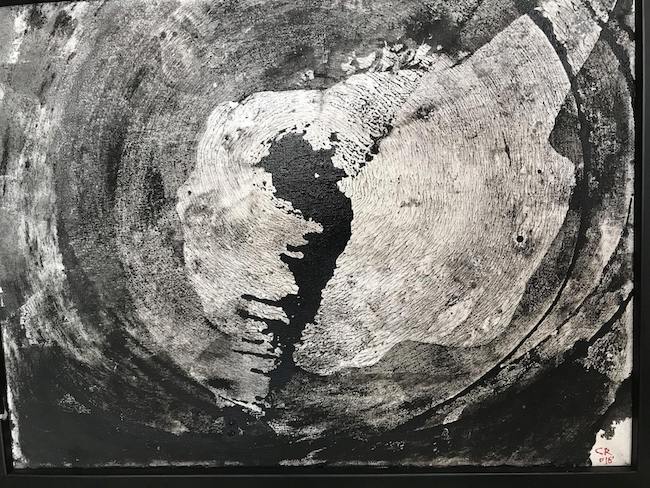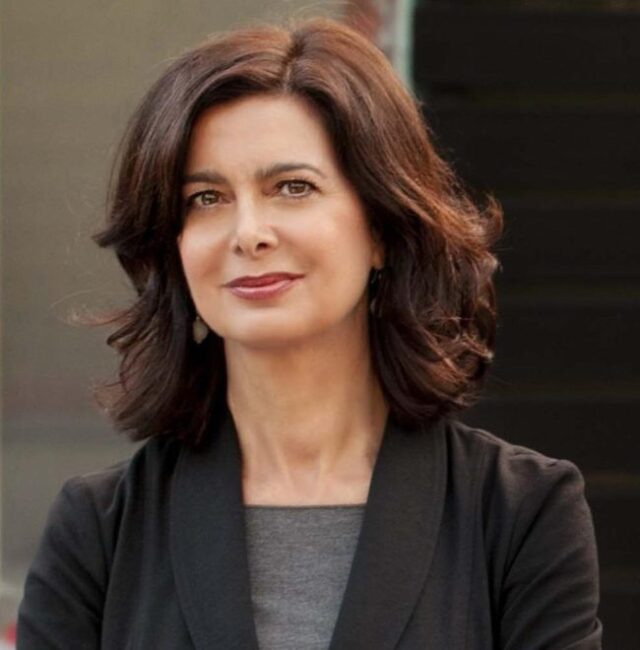Tutto ciò che costituisce uno stato d’animo, una realtà osservabile dal punto di vista emozionale, un moto interiore attraverso cui viene filtrato tutto ciò che circonda l’essere umano così come l’artista, assume connotazioni espressive differenti sulla base dell’approccio alla vita, del modo di guardare agli accadimenti o alla quotidianità, e della capacità di meditare, approfondendone i molteplici risvolti, per poi lasciar emergere verità nascoste e soluzioni personali volte a superarne le difficoltà e gli ostacoli. L’artista di cui vi racconterò oggi preferisce sostare nel buio per poi dare all’osservatore il modo di trovare la propria via d’uscita verso la luce.
L’Arte Informale ha avuto il potere di scuotere in maniera intensa e anche definitiva il panorama artistico internazionale della metà del Novecento, definitiva perché da quel momento in avanti tutti i rigidi schemi che avevano contraddistinto l’Astrattismo precedente, fatta eccezione per gli inizi elaborati da Vassily Kandinsky, furono superati con l’introduzione dell’emozione all’interno delle tele, quei moti dell’animo che non potevano più restare esclusi dall’approccio pittorico. Laddove infatti nel Suprematismo, nel Neoplasticismo, nell’Astrattismo Geometrico, ciò che contava era affermare la superiorità del gesto plastico su qualsiasi tipo di soggettivismo dell’esecutore dell’opera ma anche su altri mezzi di riproduzione dell’immagine come la fotografia, che in quegli anni cominciava a trovare via via più consensi proprio per la relativa immediatezza e accessibilità dal punto di vista economico. Non solo, i venti di guerra in Europa indussero gli artisti di quell’epoca a prendere le distanze da una realtà oggettiva troppo brutta, devastata e spaventosa per essere ispiratrice della bellezza e armonia richieste dall’arte, da qui la necessità di trovare un terreno diverso da quello contingente, di dar vita a un mondo creativo che doveva dimostrare quanto l’atto esecutivo fosse in grado di sussistere, di astrarsi e di emergere sopra tutto il resto dell’osservato. Con il ritorno alla pace, dunque intorno agli anni Cinquanta del Ventesimo secolo, un nutrito gruppo di artisti reclamò tuttavia l’esigenza di recuperare quel mondo emozionale troppo a lungo tenuto ai margini se non addirittura escluso dall’espressione artistica, dando vita negli Stati Uniti al movimento dell’Espressionismo Astratto, in cui l’indefinitezza era un mezzo per dar voce a quel turbinio ingovernabile del sentire interiore, e che aveva l’impulso creativo come unica linea guida per gli artisti che sceglievano di aderire alla nuova corrente. Il corrispettivo europeo di quel nuovo modo di affrontare il rapporto con la non forma prese il nome di Arte Informale che si divise tra Segnica e Materica e che in entrambi i casi sottolineava quel fondamentale legame con il mondo emozionale spesso segnato proprio dal recente passato e dalle vicissitudini internazionali; ecco dunque che alla frammentazione di linee e larghe pennellate costituite in prevalenza da colori scuri in contrasto con lo sfondo bianco delle opere di forte coinvolgimento emozionale di Emilio Vedova si alternavano le ferite, le bruciature, le liquefazioni plastiche di Alberto Burri in cui la materia era elemento imprescindibile per sottolineare e narrare le sofferenze interiori dell’artista come dell’uomo. Sia per l’Espressionismo Astratto che per l’Arte Informale dunque, ciò che contava era l’approfondimento del sentire, un’autoanalisi o semplicemente una liberazione a volte irruenta di tutte quelle emozioni che non avrebbero trovato un’altra modalità per essere espresse e che, esattamente per questo, avevano l’effetto di coinvolgere il pubblico, l’osservante, da un punto di vista istintivo, in virtù della forza comunicativa che veniva manifestata attraverso i colori e il gesto creativo libero.
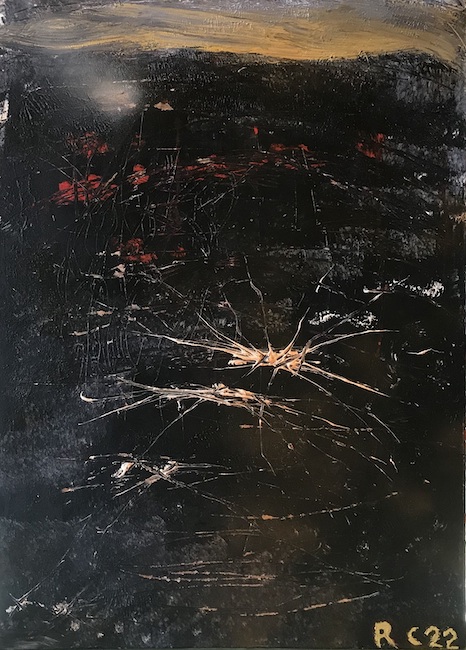
L’artista romano Remo Carradori sceglie il linguaggio Informale per raccontare liberamente e senza alcuno schema predefinito le sue emozioni ma anche il suo personale punto di osservazione di una realtà attuale spesso enigmatica, alienante e tendente a isolare l’individuo che si trova disorientato a fare i conti con tutto ciò che secondo le regole del nuovo millennio non dovrebbe essere ascoltato, mantenendo ogni cosa su un livello superficiale limitante perché poi in ogni caso quelle profondità hanno bisogno in qualche modo di essere ascoltate.
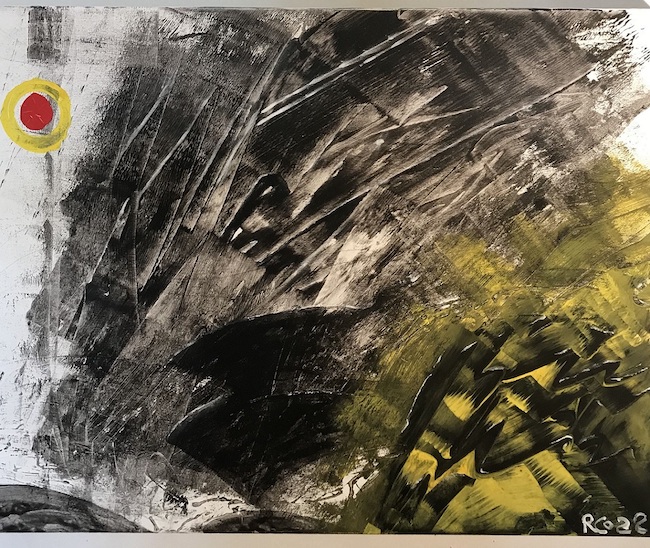
Anche lui, come Emilio Vedova, si lascia affascinare dalle ombre, dall’oscurità che però nel caso di Carradori non costituisce una ricerca del caos, o sarebbe meglio dire un lasciarsi andare alla sua forza, bensì si trasforma in strumento di esplorazione di una realtà che poi viene svelata, portata alla luce; il passaggio e lo stazionamento all’interno del buio corrisponde a una discesa verso quel mondo intimo all’interno del quale l’uomo ripone le emozioni segrete, la sua capacità empatica di entrare in contatto con circostanze e avvenimenti senza ingerenze esterne, generando perciò una personale valutazione, un pensiero, un approccio che lo induce a meditare e a elaborare.
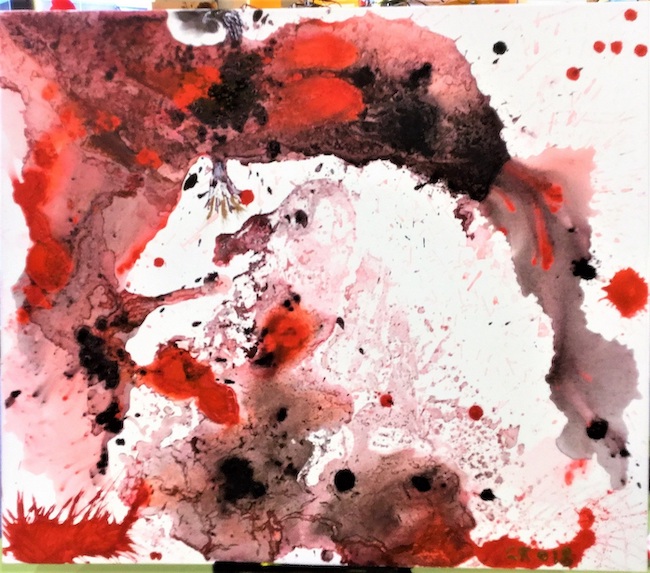
Malgrado l’oscurità del profondo però, l’artista non trascura mai di tendere verso una luminosità rappresentante il risveglio, l’apertura della coscienza che si può compiere e concretizzare solo quando il pensiero non si lascia condizionare da luoghi comuni, da strade apparentemente già tracciate secondo regole non scritte, e si può cercare il vero significato di tutto ciò che entra a far parte, per un periodo più o meno lungo, della vita del singolo.
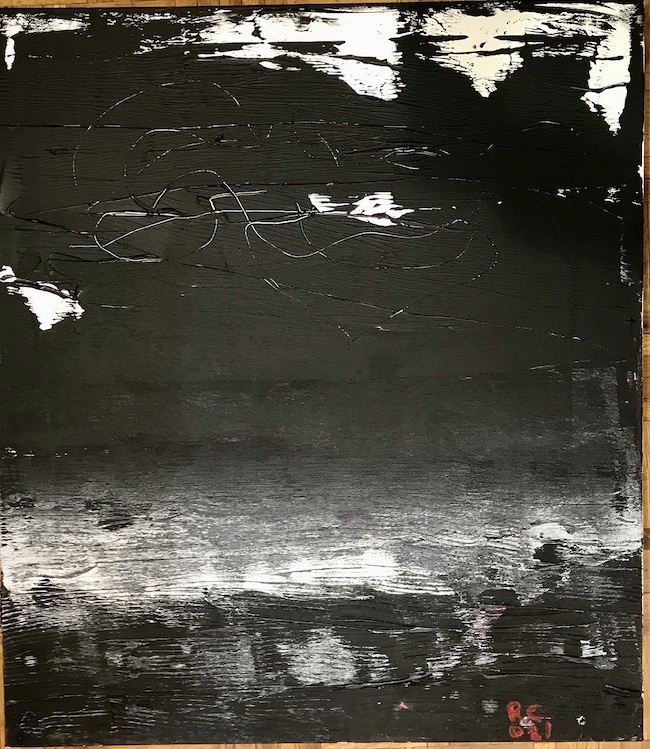
La tela Peace on earth, di forte impatto emotivo, mostra un mondo cupo, buio, tanto quanto oscuro è il percorso che conduce i potenti a farsi la guerra, a rendere la terra un luogo da contendersi, dimenticando che la stessa è abitata non da pedine, non da numeri bensì da persone che spesso proprio a causa delle loro scelte avventate e sbagliate soffrono, rischiano la vita. Eppure, malgrado la cupezza della contingenza, a dispetto di quelle ombre che sembrano ammantare l’umanità e il paesaggio descritto, Carradori lascia lampi di chiarore, squarci di speranza che prima o poi si compia quel risveglio necessario al popolo per comprendere la propria forza attraverso la quale sarà possibile prendere in mano le sorti del mondo togliendole da quelle di chi si lascia prendere e sopraffare solo dalle proprie mire personali e non dal bene comune.
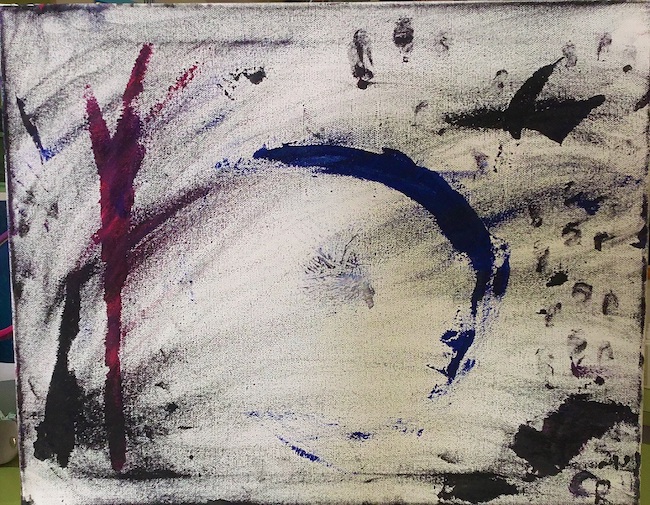
L’opera Mai più rappresenta quasi un’evoluzione ideale della tela precedente, come se, a seguito della presa di coscienza, le interiorità si fossero liberate, avessero conquistato una propria autonomia e una capacità di analisi del concatenarsi degli eventi, ed è a seguito di questa autoconsapevolezza, di questa rinascita, che l’essere umano sa di dover fare di tutto affinché le dinamiche precedenti non si verifichino di nuovo. Impedire dunque il meccanismo di causa ed effetto che ha portato al generarsi di una situazione è l’imperativo che fuoriesce da questa tela in cui la base è proprio la luminosità, la luce che porta incisi segni indelebili e incancellabili perché funzionali al monito, al memento che non deve essere rimosso dalla coscienza comune. Quando però Carradori si allontana dalle tematiche universali e si spinge verso la narrazione delle emozioni più intime e personali, allora la gamma cromatica si amplia, perché in fondo l’interiorità umana è costituita da tante caleidoscopiche sfaccettature e da risvolti inaspettati che emergono dal buio della riflessione, della tendenza a chiudersi in se stessi per proteggersi ma al tempo stesso ascoltarsi con maggiore attenzione.
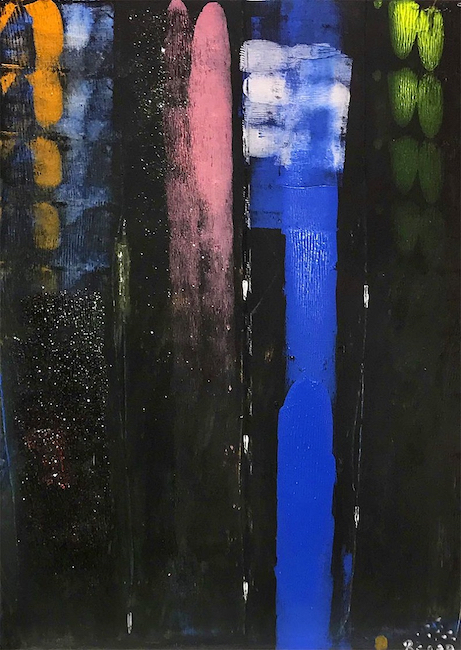
L’opera Saudade, che in brasiliano vuol dire nostalgia, rimpianto per qualcosa che si è perso, descrive attraverso le tonalità cromatiche che si stagliano dal fondo nero, il ventaglio di emozioni che si alternano nell’interiorità, quell’altalena di sensazioni che avvolgono nel momento in cui si ricorda il passato, quello ieri che non si è stati capaci di trattenere nella convinzione che sarebbe sempre rimasto lì e dimenticando così di curarsene prima di capire che invece stava sfuggendo. Anche in questo caso Remo Carradori sottolinea l’essenzialità di accogliere le proprie emozioni, di immergersi nel mare scuro dell’inconsapevolezza per raggiungere un grado maggiore di conoscenza di se stessi e di tutte le emozioni che da quel profondo emergono spesso travolgendoci; la soluzione è forse quella di avere una maggiore apertura nei confronti dei sentimenti, degli errori e delle circostanze che si susseguono così da acquisire maggiore destrezza nell’affrontare anche i rimpianti.
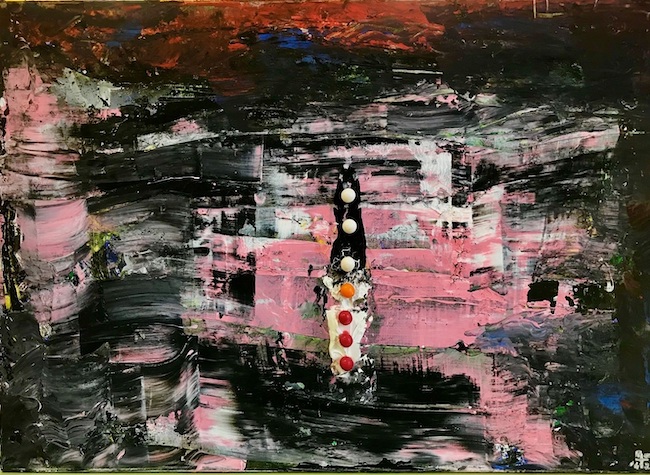
Remo Carradori ha all’attivo la partecipazione alle maggiori mostre collettive a livello europeo e le sue opere sono state inserite in pubblicazioni importanti come l’Atlante dell’Arte Contemporanea De Agostini.
REMO CARRADORI-CONTATTI
Email: remocarradori@gmail.com
Sito web: https://arteremocarradori.blogspot.com/
Facebook: https://www.facebook.com/remo.carradori
Instagram: https://www.instagram.com/remo_carradori/
Remo Carradori’s Informal Art, exploring darkness to find the sense of light
Everything that constitutes a state of mind, a reality that can be observed from an emotional point of view, an inner movement through which everything that surrounds the human being and the artist is filtered, takes on different expressive connotations based on the approach to life, the way of looking at events or everyday life, and the ability to meditate, delving into its many aspects, in order to then allow hidden truths and personal solutions to emerge, aimed at overcoming difficulties and obstacles. The artist I am going to tell you about today prefers to stay in the dark and then give the observer the opportunity to find his own way out into the light.
Informal Art had the power to shake the international art scene of the mid-twentieth century in an intense and even definitive way, definitive because from that moment on all the rigid schemes that had distinguished the previous Abstractionism, with the exception of the beginnings elaborated by Vassily Kandinsky, were overcome with the introduction of emotion into the canvases, those motions of the soul that could no longer be excluded from the pictorial approach. Where in fact in Suprematism, Neoplasticism and Geometric Abstraction, what counted was to affirm the superiority of the plastic gesture over any kind of subjectivism of the artwork’s executor, but also over other means of image reproduction such as photography, which in those years was beginning to find more and more consensus due to its relative immediacy and accessibility from an economic point of view. Not only that, the winds of war in Europe induced the artists of that period to distance themselves from an objective reality that was too ugly, devastated and frightening to inspire the beauty and harmony required by art, hence the need to find a different terrain from the contingent one, to give life to a creative world that had to demonstrate how the executive act was able to subsist, to abstract itself and emerge above everything else observed. However, with the return to peace, around the 1950s, a large group of artists reclaimed the need to recover the emotional world that had for too long been kept on the margins of artistic expression, if not excluded from it.
This gave rise in the United States to the Abstract Expressionist movement, in which indefiniteness was a means of giving voice to the ungovernable whirlwind of inner feeling, and which had the creative impulse as its only guideline for artists who chose to adhere to the new current. The European counterpart of this new way of tackling the relationship with non-form took the name of Informal Art, which was divided between Sign and Matter and in both cases underlined that fundamental link with the emotional world often marked by the recent past and by international vicissitudes; thus, the fragmentation of lines and broad brushstrokes made up mainly of dark colours contrasting with the white background of Emilio Vedova’s emotionally charged artworks took turns with Alberto Burri’s wounds, burns and plastic liquefactions, in which matter was an essential element for emphasising and narrating the inner suffering of the artist as of the man. For both Abstract Expressionism and Informal Art, therefore, what counted was the deepening of feelings, a self-analysis or simply a sometimes impetuous release of all those emotions that would not have found another way to be expressed and which, precisely for this reason, had the effect of involving the public, the observer, from an instinctive point of view, by virtue of the communicative force that was manifested through the colours and the free creative gesture. The Roman artist Remo Carradori chooses the Informal language to narrate freely and without any predefined scheme his emotions but also his personal point of observation of a current reality that is often enigmatic, alienating and tends to isolate the individual who finds himself disoriented to come to terms with everything that, according to the rules of the new millennium, should not be listened to, keeping everything on a limiting superficial level because then in any case those depths need in some way to be heard.
Like Emilio Vedova, he too allows himself to be fascinated by shadows, by obscurity which, however, in Carradori’s case, does not constitute a search for chaos, or it would be better to say a surrender to its force, but is transformed into an instrument for exploring a reality that is then revealed, brought to light; the passage and stationing within the darkness corresponds to a descent towards that intimate world within which man stores his secret emotions, his empathic ability to come into contact with circumstances and events without external interference, thus generating a personal evaluation, thought and approach that leads him to meditate and elaborate. Despite the darkness of the depths, however, the artist never neglects to tend towards a luminosity representing the awakening, the opening up of consciousness that can only be achieved and made concrete when thought does not allow itself to be conditioned by commonplaces, by roads apparently already mapped out according to unwritten rules, and one can seek the true meaning of everything that becomes part, for a more or less long period, of the life of the individual. The painting Peace on Earth, with its strong emotional impact, shows a dark, gloomy world, as shadowy as the path that leads the powerful to wage war against each other, to make the earth a place to be fought over, forgetting that it is inhabited not by pawns, not by numbers, but by people who often suffer and risk their lives precisely because of their rash, wrong choices. And yet, despite the gloom of the contingency, in spite of those shadows that seem to cloak humanity and the landscape described, Carradori leaves flashes of light, glimpses of hope that sooner or later will take place that awakening necessary for people to understand their own strength, through which it will be possible to take the fate of the world into their own hands, removing it from those of the ones who allow themselves to be taken over and overwhelmed only by their own personal aims and not by the common good. The work Mai più (Never more) represents almost an ideal evolution of the previous canvas, as if, following the realisation of consciousness, the interiorities had freed themselves, had gained their own autonomy and a capacity to analyse the chain of events, and it is following this self-awareness, this rebirth, that the human being knows he must do everything to prevent the previous dynamics from occurring again.
Preventing the mechanism of cause and effect that led to the creation of a situation is the imperative that emerges from this canvas in which the basis is precisely luminosity, the light that bears permanent and indelible signs because it serves as a warning, a reminder that must not be removed from the common consciousness. When, however, Carradori moves away from universal themes and tends towards the narration of more intimate and personal emotions, then the chromatic range widens, because after all, human interiority is made up of so many kaleidoscopic facets and unexpected implications that emerge from the darkness of reflection, of the tendency to close in on oneself to protect but at the same time to listen with greater attention. The artwork Saudade, which in Brazilian means nostalgia, regret for something that has been lost, describes through the chromatic tones that stand out from the black background, the range of emotions that alternate in the interiority, that seesaw of sensations that envelop at the moment of remembering the past, that yesterday that was not possible to hold on to in the conviction that it would always remain there and thus forgetting to take care of it before realising that it was slipping away. Also in this case Remo Carradori underlines the essentiality of accepting one’s own emotions, of plunging into the dark sea of unconsciousness in order to reach a greater degree of knowledge of oneself and of all the emotions that emerge from that depth, often overwhelming; the solution is perhaps that of having a greater openness towards feelings, errors and circumstances that follow one another so as to acquire greater dexterity in facing even regrets. Remo Carradori has participated in major collective exhibitions throughout Europe and his artworks have been included in important publications such as the Atlante dell’Arte Contemporanea De Agostini.


